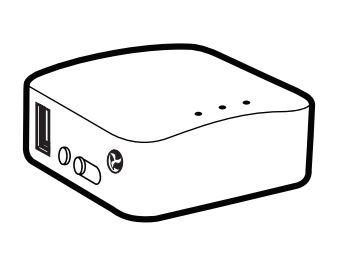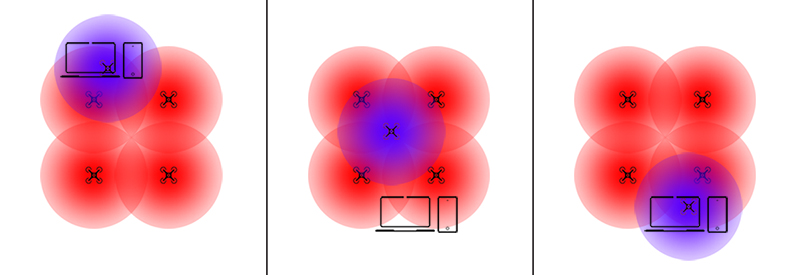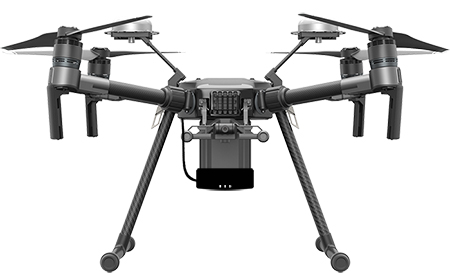18/07/2019 -
Today Internet is an increasingly popular tool used by billions of users. The rapid evolution of technology, and the continuous progress that particularly affects the world of information technology and communications have made the global network a necessary tool for many ordinary activities: email, messaging, phone calls, payments, video surveillance are just some of the operations that use Internet access daily.
Its distribution and the vast infrastructure that guarantees its usability by users located all over the world is undoubtedly a unique work, which is unprecedented in size and complexity. It is a largely efficient and robust system, but has the vulnerabilities of any plant. In fact, guaranteeing Internet access in emergency situations could be difficult following the interruption of transmission lines due to natural disasters or accidents.
Similarly, there are still several areas where an Internet connection is not present with sufficient coverage; even in these places, in case of need, guaranteeing connection coverage may not be easy. The idea considered for this project consists in the use of mesh-networking algorithms in order to create networks for situations such as those described above.
Mesh-networks (often abbreviated to "mesh-net") are networks that - among the various and numerous achievable topologies - are characterized by self-configuration and optimization functions. A computer network can in fact be structured in many different ways, with connection schemes between the various nodes (called, in fact, "topologies") that are also strongly different from each other. If, traditionally, the topology graph is a design feature that constantly remains in the operation of the network, mesh-networks introduce a new concept with great potential in this regard. They are able to establish new connections between the nodes that compose them or to interrupt others, in order to continuously change the topology adapting it to the requirements of the scenario in which they operate.

The dynamic behavior of mesh-networks is not limited to optimizing performance by always creating new topologies, but contributes strongly to ease of installation. A network of this type does not require large initial configuration operations: it is not necessary to decide which routers will serve which users, nor how the various devices will have to connect to each other. Simplifying, we can say that the network is able to start and develop autonomously.
In the same way, the dynamism and the predisposition to changes of a mesh-network make it efficient in case of failures or interruptions of connections: thanks to its ability to reconfigure and reorganize the topology, it is able to deal with events of this type by reacting in good time and restoring the correct network coverage, limited to what is made possible by the physical devices availability in the areas concerned.

Among the many solutions available, a mesh-networking software, called LibreMesh, has been identified. It is an Italian open source project, whose purpose is to provide firmware to transform ordinary network devices into nodes of a mesh-network. Numerous tests have been carried out on a network developed with LibreMesh, in order to verify its correct functioning, observe its behavior by studying the strategies and decisions that the network takes independently, and quantitatively assessing the performance that this is able to provide to users.
For correct and truthful tests, it was decided to proceed, instead of through simulations with virtual machines, by installing LibreMesh on physical devices. The GL.iNet Ar300m mini-routers were chosen for this purpose. These devices are distinguished by very small physical dimensions, low weight and limited consumption, while guaranteeing good functionality and high level performance.

The tests carried out with the combination of LibreMesh and GL.iNet AR300M involved a maximum of 3 routers and 3 hosts, and made it possible to highlight the advantages and strengths of the mesh network, but also some weaknesses. The software iperf3 was used for the numerical evaluation of the performances, which made it possible to observe - in the various scenarios implemented - the behavior of the network in the transfer of data packets, and to evaluate the average Bandwidth provided in such transfer processes.
Overall, it was concluded that the outcome of the tests carried out on the combination of hardware and software identified is positive. The developed mesh network behaves intelligently and efficiently, developing optimized topologies based on the characteristics of the scenario. The observed performances are also satisfactory, and outline an efficiency of the mesh-networking algorithm in line with what was expected.
After evaluating hardware and software, and ascertaining their compatibility, a scenario where drones are involved for the transport of network devices was hypothesized, in order to create a mesh-network suitable for emergency situations as described in the opening. A network of this type, in fact, could adapt to situations of different geographic conformation by exploiting the possibility of movement of the nodes, thanks to the use of aircraft for the realization of signal coverage. The characteristics that such a network should have were therefore estimated, starting with the definition of the number of drones necessary to cover a given area. To facilitate and automate this calculation, a script has been created: it allows to insert some data related to the situation to be examined and to simulate the coverage of a geographical area with drones in flight, first of all determining how many these should be. Some additional performance information - such as the ideal location of the network node provided with Internet access - is computed independently by the script.
The tool works online, and is available at the following link:
StarMesh script
A comparison of the mesh network with a hypothetical traditional network used for the same purpose confirmed that mesh-networking is the most suitable solution for a similar scenario, and that its autonomy in configuration is an almost necessary condition for application with drones.
The additional functionalities that can arise from the ability of drones to move freely in space, an unusual feature for a network node, were then discussed. In this regard, numerous hypotheses of dynamic behaviors such as exchange of positions and overflight of overcrowded areas by auxiliary drones have been considered, in order to determine an increase in the stability of the network and its performance.

Finally, a project proposal was made. This is not a detailed and complete design, but a more concrete and practical idea of how the tested technologies and the scenarios discussed could be combined to create a mesh-network with drones. Some problems that would undoubtedly be encountered in the development of the project have been addressed, such as disruptions related to the limited autonomy of the batteries or unfavorable weather conditions for the flight of the drones. The analysis of these eventualities and the proposal of solutions was accompanied, in conclusion, by the enumeration of the requirements that a drone should have in order to be used in the project. The DJI m200 aircraft was chosen as a model for its features and functionality, making it possible to summarize the performance expected from the network.

The project, developed as a thesis for the degree in Information and Communications Engineering under the supervision of prof. Granelli at the University of Trento, is described and documented in the final paper, available at the following link:
Download thesis PDF
Similarly, there are still several areas where an Internet connection is not present with sufficient coverage; even in these places, in case of need, guaranteeing connection coverage may not be easy. The idea considered for this project consists in the use of mesh-networking algorithms in order to create networks for situations such as those described above.
Mesh-networks (often abbreviated to "mesh-net") are networks that - among the various and numerous achievable topologies - are characterized by self-configuration and optimization functions. A computer network can in fact be structured in many different ways, with connection schemes between the various nodes (called, in fact, "topologies") that are also strongly different from each other. If, traditionally, the topology graph is a design feature that constantly remains in the operation of the network, mesh-networks introduce a new concept with great potential in this regard. They are able to establish new connections between the nodes that compose them or to interrupt others, in order to continuously change the topology adapting it to the requirements of the scenario in which they operate.

The dynamic behavior of mesh-networks is not limited to optimizing performance by always creating new topologies, but contributes strongly to ease of installation. A network of this type does not require large initial configuration operations: it is not necessary to decide which routers will serve which users, nor how the various devices will have to connect to each other. Simplifying, we can say that the network is able to start and develop autonomously.
In the same way, the dynamism and the predisposition to changes of a mesh-network make it efficient in case of failures or interruptions of connections: thanks to its ability to reconfigure and reorganize the topology, it is able to deal with events of this type by reacting in good time and restoring the correct network coverage, limited to what is made possible by the physical devices availability in the areas concerned.

Among the many solutions available, a mesh-networking software, called LibreMesh, has been identified. It is an Italian open source project, whose purpose is to provide firmware to transform ordinary network devices into nodes of a mesh-network. Numerous tests have been carried out on a network developed with LibreMesh, in order to verify its correct functioning, observe its behavior by studying the strategies and decisions that the network takes independently, and quantitatively assessing the performance that this is able to provide to users.
For correct and truthful tests, it was decided to proceed, instead of through simulations with virtual machines, by installing LibreMesh on physical devices. The GL.iNet Ar300m mini-routers were chosen for this purpose. These devices are distinguished by very small physical dimensions, low weight and limited consumption, while guaranteeing good functionality and high level performance.

The tests carried out with the combination of LibreMesh and GL.iNet AR300M involved a maximum of 3 routers and 3 hosts, and made it possible to highlight the advantages and strengths of the mesh network, but also some weaknesses. The software iperf3 was used for the numerical evaluation of the performances, which made it possible to observe - in the various scenarios implemented - the behavior of the network in the transfer of data packets, and to evaluate the average Bandwidth provided in such transfer processes.
Overall, it was concluded that the outcome of the tests carried out on the combination of hardware and software identified is positive. The developed mesh network behaves intelligently and efficiently, developing optimized topologies based on the characteristics of the scenario. The observed performances are also satisfactory, and outline an efficiency of the mesh-networking algorithm in line with what was expected.
After evaluating hardware and software, and ascertaining their compatibility, a scenario where drones are involved for the transport of network devices was hypothesized, in order to create a mesh-network suitable for emergency situations as described in the opening. A network of this type, in fact, could adapt to situations of different geographic conformation by exploiting the possibility of movement of the nodes, thanks to the use of aircraft for the realization of signal coverage. The characteristics that such a network should have were therefore estimated, starting with the definition of the number of drones necessary to cover a given area. To facilitate and automate this calculation, a script has been created: it allows to insert some data related to the situation to be examined and to simulate the coverage of a geographical area with drones in flight, first of all determining how many these should be. Some additional performance information - such as the ideal location of the network node provided with Internet access - is computed independently by the script.
The tool works online, and is available at the following link:
A comparison of the mesh network with a hypothetical traditional network used for the same purpose confirmed that mesh-networking is the most suitable solution for a similar scenario, and that its autonomy in configuration is an almost necessary condition for application with drones.
The additional functionalities that can arise from the ability of drones to move freely in space, an unusual feature for a network node, were then discussed. In this regard, numerous hypotheses of dynamic behaviors such as exchange of positions and overflight of overcrowded areas by auxiliary drones have been considered, in order to determine an increase in the stability of the network and its performance.

Finally, a project proposal was made. This is not a detailed and complete design, but a more concrete and practical idea of how the tested technologies and the scenarios discussed could be combined to create a mesh-network with drones. Some problems that would undoubtedly be encountered in the development of the project have been addressed, such as disruptions related to the limited autonomy of the batteries or unfavorable weather conditions for the flight of the drones. The analysis of these eventualities and the proposal of solutions was accompanied, in conclusion, by the enumeration of the requirements that a drone should have in order to be used in the project. The DJI m200 aircraft was chosen as a model for its features and functionality, making it possible to summarize the performance expected from the network.

The project, developed as a thesis for the degree in Information and Communications Engineering under the supervision of prof. Granelli at the University of Trento, is described and documented in the final paper, available at the following link: